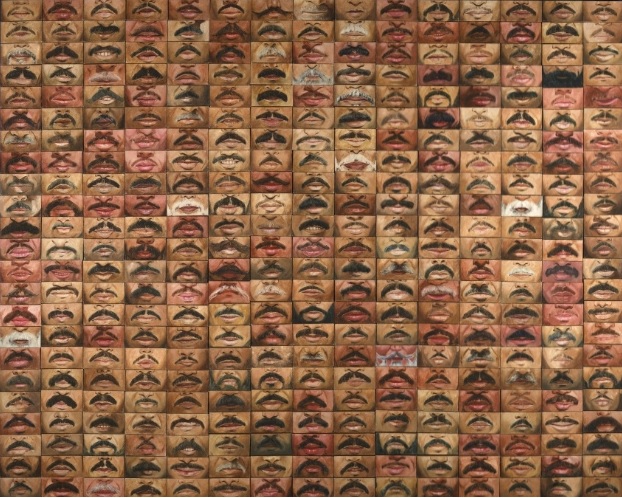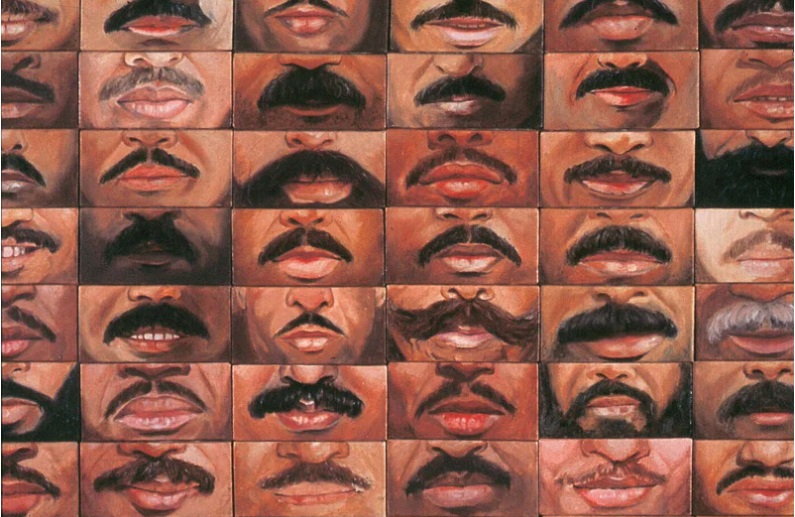Why men will always be men? How could men manage the ‘Menness’ in their bodies as a symbol? A six-pack muscle symbolised Men as masculine image. But masculinity has never been satisfied with the ‘Six-pack’ body that anyone can make with a proper workout.
A moustache is solid to express ‘Menness’ in social settings. Is the moustache a symbol of Men for many centuries? Looking into history, we get enough visual evidence for moustache-masculine links. Men build boldness, power, and masculinity through their moustaches, exhibiting themselves as vigour through their steadied, shaped moustache faces. Facial hair tells a story of dramatic societal social, and economic changes.
We should know that the hair that grows under the nose helps them to create an ambience of masculinity, and men use that to control the surrounding world. London-based Indian artist Bharti Kher brings the idea of masculinity in her ‘Hirsute’ (1999) and discusses the ‘Indian’ version of moustache and masculinity.
‘I didn’t know how to deal with the masculine gaze, which was penetrating and could be extremely personal in some ways. With a camera, I stopped guys in the street with moustaches and asked, “Can I take your photo?” Strangely, a camera can disarm people, and they sometimes like having their photos taken. So mostly, they were all smiles, and anyone with a moustache, from my guards and taxi drivers to the cigarette and pan wallah, to my neighbours, were very compliant. So I did about 225 of them. Then I just got tired of it because I had to paint them too; Artist Bharti Kher said about this painting about the beginning and the process in a conversation.

The men occupy Public spaces with a solid masculine ambience, building with many things, including moustaches. Artist Bharti Kher uses this painting to discuss an influential element of masculinity in public-private social life, and that element brings on the topic of gender bias.
In Livia Gershon’s essay on moustaches and their meaning, she quoted Oldstone-Moore and brought the historical portrayals of moustaches. “In a time of rapid economic and social change, men grew beards or moustaches to underscore the natural virtues, and supposedly imprescriptible rights, of men.” Toward the end of the nineteenth century, full beards came into fashion in Europe and America. Meanwhile, most European armies required their officers—and sometimes enlisted men, too—to wear moustaches. Livia Gershon’s writes turned them into a symbol of dashing masculinity that civilian men quickly adopted.
Hair has never been a natural element that grows naturally, but it carries the meaning of masculinity and brings power and hierarchy to our social settings. This hair code routed and reveals the principle of gender bias and difference, and the moustaches shape masculinity in the social relationship between people and gender.
In this painting, Bharti Kher portrays the masculine feature of hair growth, which use the male as their power of the gaze, transcending the notion of masculinity throughout their life.
Oldstone-Moore writes about the changes in facial hair and its power and how these are related as personal and political statements that allow them to prompt the socio-political entity of society. ‘The history of men is written on their faces, as write Oldstone-Moore, and Bharti Kher visualising the narrative as a tool for understanding the shift of social change.
This painting matters because the facial hair is political, which tells about ‘you’ and the society that constructs ‘you’. Moustaches that reshaped and retold the remarkable story of gender bias in our contemporary India. This painting results from a photographic journey through the artist’s personal space, including her community, from different ages, areas, and domains. Artists bring the contrast and social norms constructed in realms of moustaches that tell us, as ‘the language of facial hair is built on the contrast of shaved and unshaved’ written by Oldstone-Moore.
Reference:
Google Art and Culture
daily.jstor.org
mommybysilasandstathacos.com

Krispin Joseph PX, a poet and journalist, completed an MFA in art history and visual studies at the University of Hyderabad.






